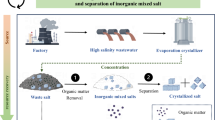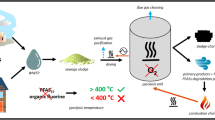Abstract
There are few study examples on the separation of metals by floating method. In this study, separation of silicon and aluminum, which are the main components of silicon-based solar cell module, was carried out by floating method in order to purify silicon from waste solar cell module. The selection of surfactant, control of electric charge, wettability of the solid particles, surface tensions, and bubble surface area are important for separation of solids by floating method. Sodium dodecyl sulfate (SDS) can increase the hydrophobicity of aluminum powder due to the difference of surface potentials between silicon and aluminum. SDS behaves as a collector of aluminum as well as a frothing agent to decrease the bubble size. At a SDS concentration of 2 g/L and sample dipping time of 10 min, 80.1 mass% of aluminum was floated and separated, and the sedimentary silicon reached a purity of 90.7% from a mixture of 50 mass% aluminum and 50 mass% silicon. Finally, at a pH value of 7.0, SDS concentration between 1.0 and 2.5 g/L and air flow rate of 2.5 L/min (STP) were suitable experimental conditions to purify silicon from a mixture of silicon and aluminum by flotation separation method.
















Similar content being viewed by others
References
IEA International Energy Agency (2018) Snaphot of global photovoltaic, In: Report IEA PVPS T1-33:2018
Louwen A, van Sark WGJHM, Faaij APC, Schropp RE, Ruud I (2016) Re-assessment of net energy production and greenhouse gas emissions avoidance after 40 years of photovoltaics development. Nat Commun 13728(7):1–9
Ministry of the Environment Government of Japan (2016) http://www.env.go.jp/press/files/jp/102441.pdf. Accessed 28 Jan 2019
Dias P, Schmidt L, Gomes LB, Bettanin A, Veit H, Bernardes AM (2018) Recycling waste crystalline silicon photovoltaic modules by electrostatic separation. J Sustain Metall 4(2):176–186
Park J, Kim W, Cho N, Lee H, Pak N (2016) An eco-friendly method for reclaimed silicon wafers from a photovoltaic module: from separation to cell fabrication. Green Chem 18:1706–1714
Tsoutsos T, Frantzeskaki N, Gekass V (2005) Environmental impacts from the solar energy technologies. Energy Policy 33(3):289–296
Matsubara T, Uddin MA, Kato Y, Kawanishi T, Hayashi Y (2018) Chemical treatment of copper and aluminum derived from waste crystalline silicon solar cell modules by mixed acids of HNO3 and HCl. J Sustain Metall 4(3):378–387
Union European (2012) Directive 2012/19/EU of the European Parliament and of the Council of 4 July 2012 on waste electrical and electronic equipment (WEEE). Off J Eur Union 197:38–71
Doi T, Tsuda I, Unagida H, Murata A, Sakuta K, Kurokawa K (2001) Experimental study on PV module recycling with organic solvent. Solar Energy Mater Solar Cells 67(1):397–403
Jung B, Park J, Seo D, Park N (2016) Sustainable system for raw-metal recovery from crystalline silicon solar panels: from noble-metal extraction to lead removal. Sust Chem Eng 4(8):4079–4083
Radziemska EK, Ostrowski P (2010) Chemical treatment of crystalline silicon solar cells as a method of recovering pure silicon from photovoltaic modules. Renew Energy 35(8):1751–1759
Kang S, Yoo S, Lee J, Bonghyun B, Ryu H (2012) Experimental investigations for recycling of silicon and glass from waste photovoltaic modules. Renew Energy 47:152–159
Yi YK, Kim HS, Tran T, Hong SK, Kim MJ (2014) Recovering valuable metals from recycled photovoltaic modules caption list. J Air Waste Manag Assoc 64(7):797–807
Huang WH, Shin WJ, Wang L, Sun WC, Tao M (2017) Strategy and technology to recycle wafer-silicon solar modules. Sol Energy 144(1):22–31
Acker J, Henbge A (2007) Chemical analysis of acidic silicon etch solutions II. Determination of HNO3, HF and H2SiF6 by ion chromatography. Talanta 72:1540–1545
New Energy and Industrial Technology Development (NEDO) (2015) https://www.nedo.go.jp/content/100758482.pdf. Accessed 28 Jan 2019
Mukai S (1959) On floatation method [Fuyusenkoho ni tuite]. J Chem Eng Jpn 23(7):480–486
Wada M (1943) Investigations into the network effect of loose foams in liquid solutions on paraffin. Contributions to floating foam processes [Untersuchungen uber die netzwirkung der schaumer in wasserigen losungen auf parain. Beitrage zum schaumschwimmverfahren]. (Mitteihung 1-2). J Min Inst Jpn 59(704):681–698
Isomatsu R (1961) On removal of iron sulfide from pottery stone by flotation method [Fusenho niyoru toseki no ryukatetsu zyokyo ni tsuite]. J Chem Eng Jpn 25(7):547–553
Numata Y, Yokoyama Y, Wakamatsu T (1979) Fundamental studies on the behavior of a-terpineol and cineol as a frother in sulfide mineral flotation. J Min Metall Inst Jpn 95(1098):461–465
Chen Z, Nishimura S, Sasaki H, Usui S (1990) Cationic flotation of fine quartz using dodecyltrimethylammonium bromide (DTAB). Shigen-to-Sozai 106(9):521–525
Wang J, Wang H, Wang C, Zhang L, Wang T, Zheng L (2017) A novel process for separation of hazardous poly (vinyl chloride) from mixed plastic wastes by froth flotation. Waste Manag 69:59–65
Wang C, Wang H, Fu J, Zhang L, Luo C, Liu Y (2015) Flotation separation of polyvinyl chloride and polyethylene terephthalate plastics combined with surface modification for recycling. Waste Manag 45:112–117
Marques GA, Tenorio AS (2000) Use of froth flotation to separate PVC/PET mixtures. Waste Manag 20(4):265–269
Truc NTT, Lee BK (2016) Sustainable and selective separation of PVC and ABS from a WEEE plastic mixture using microwave and/or mild-heat treatment with froth flotation. Environ Sci Technol 50(19):10580–10587
Eivazihollagh A, Tejera J, Svanedal I, Edlund H, Blanco A, Norgren M (2017) Removal of Cd2+, Zn2+, and Sr2+ by ion flotation, using a surface-active derivative of DTPA (C12-DTPA). Ind Eng Chem Res 56(38):10605–10614
Dey S, Paul GM, Pani S (2013) Flotation behaviour of weathered coal in mechanical and column flotation cell. Powder Technol 246:689–694
Yamasaki T (1969) Application of surfactants for flotation. J Jpn Oil Chem Soc 18(7):417–426
Esumi K (1997) Characteristics and application of surfactant adsorbed layers formed on particles. J JSCM 70(10):675–685
Umeda H, Sasaki A, Takahashi K, Haga K, Takasaki Y, Kuzuno E, Shibayama A (2011) Flotation and process design for precious metals recovery from powdery waste generated by polishing process of dental alloy. J MMIJ 127(10_11):649–655
Nakazawa H, Sato T, Oikawa K, Kagesawa K (1993) Recovery of precious metals from dental material waste by flotation. Shigen-to-Sozai 109(11):879–884
Ito R, Dodbiba G, Sadaki A, Ahn JW, Fujita T (2007) Recovery of heavy metals by flotation from incinerated automobile shredder residues. Resour Process 54(3):152–157
Matsuoka I (1982) Flotation of oxide minerals. J Min Metall Inst Jpn 98(1134):664–670
Somasundaran P, Fuerstenau DW (1966) Mechanisms of alkyl sulfonate adsorption at the alumina-water interface. J Phys Chem 70(1):90–96
Aixing F, Somasundaran P, Turro NJ (1997) Adsorption of alkyltrimenthylammonium bromides on negatively charged alumina. Langmuir 13(3):506–510
Koopal LK, Lee EM, Bohmer MR (1995) Adsorption of cationic and anionic surfactants on charged metal oxide surfaces. J Colloid Interface Sci 170(1):85–97
Thermo Scientific™. Sodium Dodecyl Sulfate (SDS), Lauryl. https://www.thermofisher.com/order/catalog/product/28364. Accessed 28 Jan 2019
Kato Y, Hanazawa K, Baba H, Nakamura N, Yuge N, Sakaguchi Y, Hiwasa S, Aratani F (2000) Purification of metallurgical grade silicon to solar grade for use in solar cell wafers. Tetsu-to-Hagane 86(11):717–724
Acknowledgements
This study was carried out under the project of NEDO (New Energy and Industrial Technology Development Organization), entitled “Development project for photovoltaic (PV) recycling technology”.
Author information
Authors and Affiliations
Corresponding author
Additional information
The contributing editor for this article was Hongmin Zhu.
Publisher's Note
Springer Nature remains neutral with regard to jurisdictional claims in published maps and institutional affiliations.
Rights and permissions
About this article
Cite this article
Harada, S., Uddin, M.A., Kato, Y. et al. Separation Between Silicon and Aluminum Powders Contained Within Pulverized Scraped Silicon-Based Waste Solar Cells by Flotation Method. J. Sustain. Metall. 5, 551–560 (2019). https://doi.org/10.1007/s40831-019-00246-6
Published:
Issue Date:
DOI: https://doi.org/10.1007/s40831-019-00246-6




